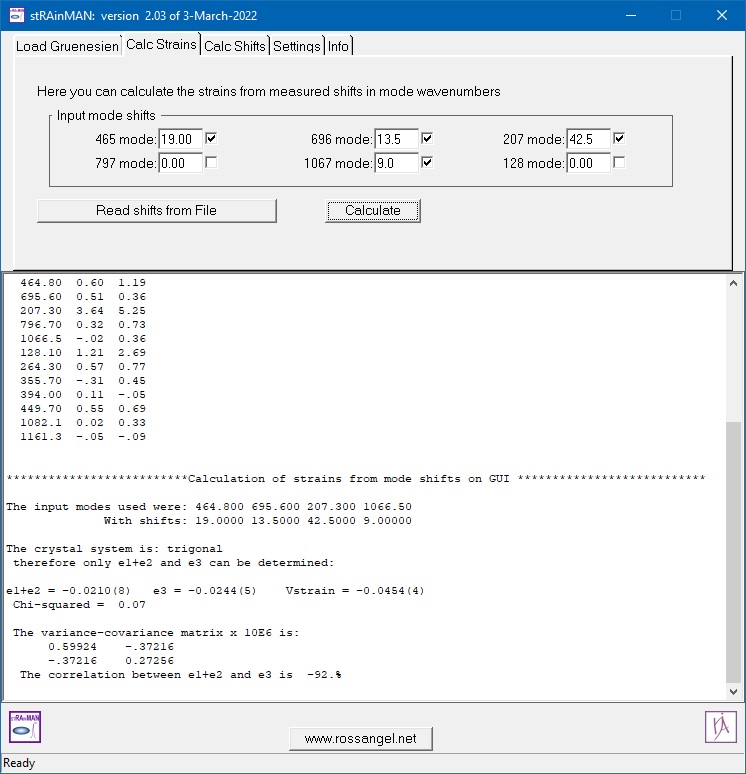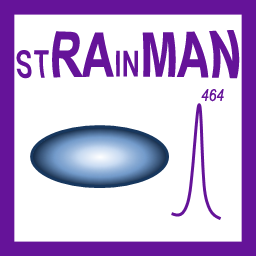stRAinMAN is a computer program for Windows
that calculates the changes in phonon mode wavenumbers of crystals from the strains applied to
the crystal, as well as the strains from measured changes in mode wavenumbers, by using the concept
of the phonon-mode Grueneisen tensor. The program name emphasises its most important application,
which is the determination of strains in crystals by using Raman spectroscopy
to measure changes in phonon wavenumbers relative to an unstrained crystal.
However, the program can be used for any phonon mode in a crystal whether or not it is Raman- or infrared-active.
The program is described in an open-access article
in Zeitschrift fuer Kristallographie by Angel and co-authors,
which also includes the theoretical background. The manuscript is included in the installation.
stRAinMAN was developed with the support of ERC starting grant 714936
‘True Depths’ to Matteo Alvaro in Pavia.
stRAinMAN is most widely used to determine the strains of inclusions trapped inside other minerals deep within the Earth.
Once you have determined the strains, they can be used in the EosFit-Pinc or
EntraPT programs to calculate the pressure and temperature
conditions under which they were trapped.
The screenshot below shows the Calc Strains tab of the stRAinMAN GUI showing the strains
calculated from the changes in mode wavenumbers of quartz input into four of the boxes in the GUI.
Because there are only two independent strain quantities that can be calculated for a uniaxial crystal, such as
quartz, inputing data for at least three modes (four in the screenshot) allows the program to calculate
the uncertainties in the strains, which are shown in parentheses. The Read Shifts from File button allows
experimental data of changes in wavenumbers to be read from a list in a text file.
 |
stRAinMAN needs the mode Gruenesien tensor coefficients for the modes of
the crystal in which you are interested. You give these to the program in a text file with the format of
a crystallographic information files (cif).
Details in the program documentation, which is also
in the installer (see below). To calculate strains
from mode shifts, the mode shifts can either be input by hand, or for ease of processing large datasets,
they can be read from a data file. Examples of input files are given in the program documentation.
Latest update: Version 2.03 (March 2022)
Changes in this version:
- Improved formatting of the results to the output window and to the log file, to remove format overflows and to make the output easier to read.
Not all of the results now appear on the GUI, but a complete set of results is always available in the log file.
- The GUI now appears correctly when the scaling of the display in Windows is changed from 100%.
For full details of all updates in this version, look at the program documentation.
Installation
- Before installing, uninstall previous versions of stRAinMAN, by using the Uninstall utility in the Windows control panel.
- For Windows, Download a self-installer and run it.
- This will install the program, example files, the manuscript describing the theory, and a pdf with examples.
- After installing the program, copy the documentation and example files from c:\program files (x86)\strainman\examples to a folder under
your own \my documents.
- Read the documentation for more information and a worked example of how to use the program.
Examples
For examples of how to use the program to determine the strains of quartz inclusions inside garnets, and how to use those strains
to determine the entrapment conditions, see
- Bonazzi M, Tumiati S, Thomas J, Angel RJ, Alvaro M (2019)
Assessment of the reliability of elastic geobarometry with quartz inclusions.
Lithos, 350-351, 105201.
link
- Gilio M, Angel RJ, Alvaro M (2021) Elastic geobarometry: how to work with residual inclusion strains and pressures.
American Mineralogist, 106, 1530-1533.
link
- Gilio M, Scambelluri M, Angel RJ, Alvaro M (2022)
The contribution of elastic geobarometry to the debate on HP versus UHP metamorphism.
Journal of Metamorphic Geology, 40, 229-242.
link
|
| |
